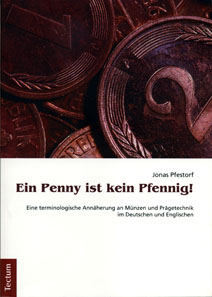by Björn Schöpe
July 10, 2012 – There are books one might not read from the first page to the last, that means books which are no novels or mysteries. However these books can be similarly intriguing and capturing, although this does not happen very often as we have to admit. Anyway, such a book is ‘Ein Penny ist kein Pfennig’ (‘A penny is not a pfennig’) by Jonas Pfestorf, a master thesis in translation. The subtitle gives only a first idea of what it is dealing with: ‘A terminological approach to coins and coining technique in German and English’. It sounds quite academic, and indeed it is very profound, but it is not annoying at all! This book will be of interest for all those who love coins, and of special aid to those who work in this sector using their language, especially when translating texts from German to English or viceversa.
Jonas Pfestorf, Ein Penny ist kein Pfennig! Eine terminologische Annäherung an Münzen und Prägetechnik im Deutschen und Englischen. Tectum Verlag, Marburg, 2011. 371 pages, bw and colour images and tables. 21 x 14.7 cm, paperback. ISBN: 978-3-8288-2810-0. 39,90 EUR.
The book is divided in three parts. The first one deals with basics and the production and description of coins. After a short overview of the history of coins the author explains what materials are used for coinage and what properties they own. Then the production technique is explained. From the manually driven screw press (‘handbetriebene Spindelpresse’) to the toggle mechanism (‘Kniehebelmechanismus’) and modern blank production and processing like rimming and coating all important steps are described. This comes in very handy when one has to explain in the other language these very technical process steps. It is a tricky issue since – as the author explains right at the beginning – some terms are not available in both languages and were therefore ‘coined’ by big firms. In this case the author followed this practice accepting the ‘standards’.
The next section is of special interest to dealers, auction houses or collectors: the description of a coin. Being a methodical person the author gives not only the translation but the explanation of the difference between – just to cite an example – legend (‘Umschrift’), inscription (‘Inschrift’) and lettering (‘Aufschrift’). Are we always conscious of the precise terminology we have at disposition? If not, make sure you have this book on your desk!
The second part deals with specific translation problems. We learn about the etymologies of words like mint and coin and their various cultural backgrounds. Very interesting is the aspect of polysemy. The author states that non specialists often do not use all possible terms for different kinds of restriking coins – ‘restrike’ is just one word, but there is ‘overstrike’ or ‘multiple strike’ as well. ‘Fantasy coin’ is another of these difficult issues the book helps you to understand. But even terms for ‘numismatics’ and special fields of it do not mean exactly the same as in English or simply do not exist in German (like ‘paranumismatica’ / ‘exonumia’), while the German term ‘Münzkunde’ has no English equivalent that is actually used. The chapter on cultural specifics in grading and quality terms is quite revealing, too.
In the following chapter the author reveals why ‘penny’ does not mean ‘pfennig’ in German, while ‘pound’ may be translated with ‘pfund’ (read it yourself, we do not want to reveal too much, just be aware of the fact that there was never a German Pfund-coin, but there was a pfennig …). After idiomatic phrases related to coins and numismatics follows part three, the glossary. You may fall back on these one hundred pages as an annotated dictionary.
As said at the beginning: this book should be at hand to everybody in the coin business who has to write in English or German and must translate texts in these languages. But we can recommend it to anyone interested in coins and language, cultural history or linguistic as well. And after all it is simply diverting read.
You can find more information on this book on the publisher’s website.
A numismatical dictionary that aims to be of help to numismatists, coin dealers and coin collectors is this one upcoming very soon.





